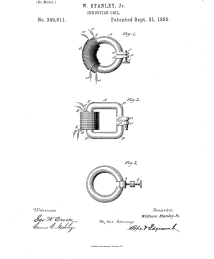William Stanley, Jr.
William Stanley Jr. invented an array of electrical devices and is best known for designing the induction coil, the first practical transformer that created alternating current (AC) electricity. Stanley’s design allowed high voltages of electricity to safely travel over long distances, making possible the widespread use of electricity.
Born in Brooklyn, New York, in 1858, Stanley was interested in mechanics from a young age. Like many great inventors, he enjoyed investigating and tinkering with devices. When he was just 10, he took apart a watch and successfully put it back together.
Though Stanley enrolled at Yale University to study law, he soon left school with the intention of finding work in the emerging field of electricity. A self-taught electrical engineer, he worked for an early manufacturer of telegraph keys and fire alarms, and later for a nickel-plating company, before taking a position with Hiram Maxim, a pioneer in the electrical industry.
When engineer, entrepreneur and fellow National Inventors Hall of Fame® Inductee George Westinghouse learned of Stanley's accomplishments, in 1885 he asked him to serve as chief engineer at his Pittsburgh factory, where Stanley began work on a transformer. Dealing with poor health due to tuberculosis, Stanley later left Pittsburgh to escape the city’s low air quality and moved to Great Barrington, Massachusetts. Here, he developed many ideas he’d previously suggested to Westinghouse, including a new kind of transformer.
In the 1880s, every system for distributing electricity had used direct current (DC). However, DC transmission over long distances was impractical. Transmitting at low voltage required thick wires, while transmitting at high voltage was dangerous and could not be reduced for consumer uses such as lighting. Though it was known that alternating AC voltage could be varied with the use of induction coils, no practical coil system had yet been invented. Stanley’s induction coil design, which he described as “a complete and simple solution to a difficult problem,” would become the prototype for all future transformers.
In March 1886, Stanley successfully demonstrated the first full AC power system by providing lighting for offices and stores on Main Street in Great Barrington. With this demonstration, which was financed by Westinghouse, Stanley proved that AC power was practical, safe and cost effective.
Stanley patented his induction coil design in 1886 and after leaving Westinghouse, founded the Stanley Electric Manufacturing Co. in Pittsfield, Massachusetts, in 1890. The company, which made transformers, auxiliary electrical equipment and electrical appliances, was purchased by General Electric (GE) in 1903. Stanley began working for GE as a consultant, and he continued to invent and innovate, producing new and improved power distribution systems.
In 1913, while working for GE and focusing on developing an electric oven, Stanley devised an unexpected application of what he’d learned through experimenting with the conductivity of different materials. He found a new way to keep coffee hot throughout the day, creating the first double-walled, vacuum-sealed bottles made entirely of steel.
At the time, the only thermoses on the market had a glass interior. These thermoses cooled quickly and were likely to shatter when dropped. In contrast, Stanley’s thermos was more durable and held heat much longer. To manufacture his thermoses, he co-founded the Stanley Insulating Co. Now known as Stanley, the brand has made trusted products for more than a century.
In addition to his patented induction coil, Stanley held more than 100 U.S. patents for inventions including lighting systems, incandescent electric lamps and their components. In 1912, he was awarded the IEEE Edison Medal.
